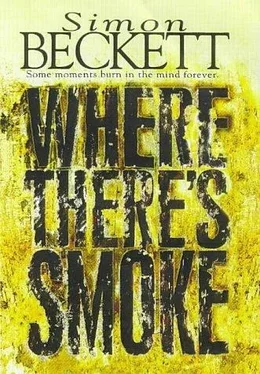Simon Beckett - Where There's Smoke
Здесь есть возможность читать онлайн «Simon Beckett - Where There's Smoke» весь текст электронной книги совершенно бесплатно (целиком полную версию без сокращений). В некоторых случаях можно слушать аудио, скачать через торрент в формате fb2 и присутствует краткое содержание. Город: London, Год выпуска: 1997, ISBN: 1997, Издательство: Hodder & Stoughton, Жанр: Триллер, на английском языке. Описание произведения, (предисловие) а так же отзывы посетителей доступны на портале библиотеки ЛибКат.
- Название:Where There's Smoke
- Автор:
- Издательство:Hodder & Stoughton
- Жанр:
- Год:1997
- Город:London
- ISBN:978-0-340-68592-1
- Рейтинг книги:5 / 5. Голосов: 1
-
Избранное:Добавить в избранное
- Отзывы:
-
Ваша оценка:
- 100
- 1
- 2
- 3
- 4
- 5
Where There's Smoke: краткое содержание, описание и аннотация
Предлагаем к чтению аннотацию, описание, краткое содержание или предисловие (зависит от того, что написал сам автор книги «Where There's Smoke»). Если вы не нашли необходимую информацию о книге — напишите в комментариях, мы постараемся отыскать её.
Where There's Smoke — читать онлайн бесплатно полную книгу (весь текст) целиком
Ниже представлен текст книги, разбитый по страницам. Система сохранения места последней прочитанной страницы, позволяет с удобством читать онлайн бесплатно книгу «Where There's Smoke», без необходимости каждый раз заново искать на чём Вы остановились. Поставьте закладку, и сможете в любой момент перейти на страницу, на которой закончили чтение.
Интервал:
Закладка:
C’s history of fire setting began at the age of ten, when he set fire to a curtain in the family home. His subsequent beating by both parents, and later his brothers, appears to have had the opposite effect to deterring him, forcing him into a spate of fire raising that culminated six months later in his burning down a shed in the local park. This resulted in the first police involvement, following which he was recommended for psychological assessment.
There followed a period of relative stability, lasting for eighteen months, when C started no fires. However, this also coincided with his going to stay with his paternal grandmother, when his father was imprisoned on a fraud charge. Away from the family home, his condition appears to have improved markedly, and it was only after his return there, following his father’s release from prison, that his fire setting resumed.
At fourteen he was caught after setting fire to school outbuildings. This time he was referred for psychiatric treatment, following which he was recognised as exhibiting negative symptoms of schizophrenia, such as withdrawal from social contact, intense apathy, and being acutely ill at ease in the presence of other people. However, C’s pyromania was ascertained to be a pathological problem rather than a symptom of his schizophrenia. At no time did he claim to have “heard” voices telling him to start fires, or report any other delusional ideas, as is typically the case when the fire setting is a result of an organic psychiatric disorder.
His compulsion to start fires, and his obsession with watching them, seems instead to have stemmed from an unconscious urge to purge himself of negative emotions. This frequently took the form of setting fire to an object associated with them (as, for instance, the attempt to burn down the school outbuildings, where he had been beaten by a gang of boys several days earlier). However, C’s intense guilt following each incident of fire setting would generally result in his becoming even more withdrawn and isolated, thereby creating a need to start further fires.
C’s schizophrenia appeared to respond well to treatment with anti-psychotic drugs, and once again his pyromania appeared to be under control. However, he was badly traumatised by the death of his paternal grandmother when he was fifteen. This came shortly after an argument between the grandmother and C’s parents, in which his welfare was the central issue. On the evening of his grandmother’s funeral, C set fire to his home, killing both his parents and brothers. Even now he still appears unclear over his intentions in setting this fire, and it is possible that it was set with no real regard for the consequences. He was interrupted by the emergency services in the act of pouring petrol over himself outside the burning house, clearly with the intention of self-immolation.
C was sectioned under the Mental Health Act, 1983, and transferred to a young person’s secure unit, where he was treated with therapy and the anti-psychotic drug Clozapine. In addition, C also received speech therapy to alleviate his stammer. He responded well, and was discharged after eight years into the supervision of a psychiatric social worker and clinical psychologist. He currently seems to have adapted well to living in the community once more, and has been found supervised work within it. To date there has been no recurrence of fire setting, and he expresses a strong understanding of his condition, and a desire to overcome it. Although he remains under psychiatric social worker monitoring, and bi-monthly psychological assessment, there seems a good possibility that, in time, this can be reduced.
The article went on to the next case study, but Kate stopped reading. The edges of her vision darkened. She felt a tingling light-headedness, and gripped the edge of the table until the faint receded. When it had, she grabbed the photocopies and began cramming them into her bag.
Her hands were clumsy and several sheets spilled onto the floor. She bent to retrieve them, and then froze.
The man she had seen on the mortuary slab stared out at her from the top of one of the articles. The photograph was passport-sized and black and white, the face smiling in life, not stiff and disfigured, but it was unmistakably the same man. His name was printed underneath. Dr Alex Turner.
Kate made it to the toilet before she was sick.
The receptionist tried to convince her to make an appointment for later in the week but finally relented and grudgingly told Kate that she could wait to see a doctor that evening.
Kate sat on one of the hard plastic chairs in the waiting room, avoiding eye contact with any of the other patients.
An elderly man sat wheezing opposite her, one leg held out stiffly in front of him. Next to him a teenager pored over a women’s magazine in silent absorption. Nearby, a young mother read quietly to a pale-looking toddler on her knee.
Kate picked up a magazine from the table in the centre of the room, but the words and pictures made no sense. When she came to an article on miscarriages she put it down.
The fluorescent lighting took the life out of everything. The waiting room was oppressive in its silence, so that the slightest sound was amplified. The young mother’s voice murmured on in a deafening whisper. The old man’s coughs boomed from the depths of his chest while the teenager’s magazine announced each turned page in a rustle of glossy paper. Kate stared at the top of the receptionist’s head, bent over behind the glass partition, and tried to think of nothing.
One by one the other patients were called in, until she was the last one left. The old man came out and walked stiffly to the door. It squeaked shut behind him, leaving Kate alone once more.
“Kate Powell.”
She stood and went over to the receptionist’s counter. The woman slid her notes under the glass. “Room three.”
Kate walked down the corridor and tapped on the door. A man’s voice spoke from inside. She couldn’t tell what he had said, but went inside anyway.
It was a different GP from the ones she had seen before. He was an elderly man, small, with grey hair and gold half-moon glasses. Without looking up from what he was writing he held out his hand for her notes. Kate sat down and waited.
Finally he gave a small sigh and looked up. “What can I do for you?”
Kate had rehearsed what she would say. Now it all vanished. “I want an abortion,” she blurted.
The doctor looked at her over the top of his glasses. He took out her notes from the manilla envelope and read the more recent entries without answering. “You’re not quite five weeks’ pregnant. Is that right?”
Kate nodded. The doctor pursed his lips and unhurriedly flipped back through her notes. She waited, her hands clenched and white on her lap. When he saw nothing that interested him he turned back to her.
“Why do you want an abortion?”
She told him. He listened without comment, legs crossed, looking at a notepad on his desk, on which he occasionally wrote. Kate tried to keep the quaver from her voice, but by the time she had finished she was shivering uncontrollably.
She had hoped that telling someone, from beginning to end, would prove cathartic. It didn’t.
The doctor made one or two more notes. “And what does the clinic that carried out the insemination say about this? I presume you’ve told them?”
“They... they say it’s nothing to do with them. When I asked them about termination, they said I should contact my own GP.”
Dr Janson had been appalled when Kate had phoned her, and while she had tried hard not to sound unsympathetic, it was obvious that her main worry was absolving the clinic of responsibility. The choice of donor had been entirely Kate’s, she hastily pointed out, scrambling to distance the clinic from any hint of scandal. But Kate hadn’t needed anyone to tell her where the fault lay.
Читать дальшеИнтервал:
Закладка:
Похожие книги на «Where There's Smoke»
Представляем Вашему вниманию похожие книги на «Where There's Smoke» списком для выбора. Мы отобрали схожую по названию и смыслу литературу в надежде предоставить читателям больше вариантов отыскать новые, интересные, ещё непрочитанные произведения.
Обсуждение, отзывы о книге «Where There's Smoke» и просто собственные мнения читателей. Оставьте ваши комментарии, напишите, что Вы думаете о произведении, его смысле или главных героях. Укажите что конкретно понравилось, а что нет, и почему Вы так считаете.












